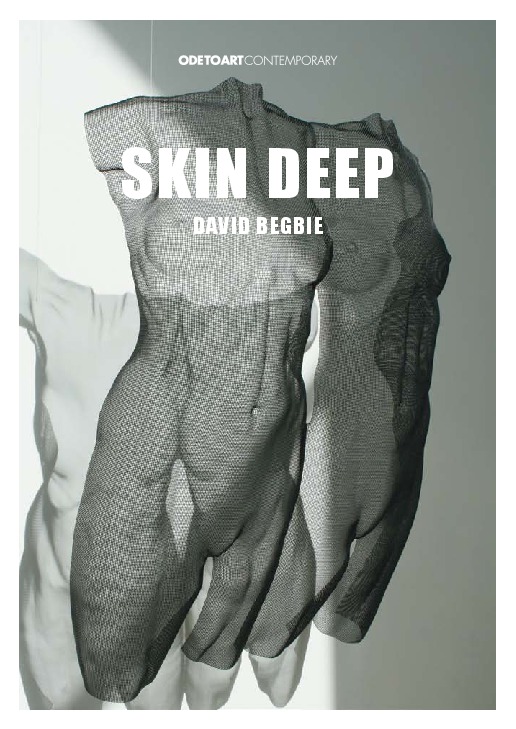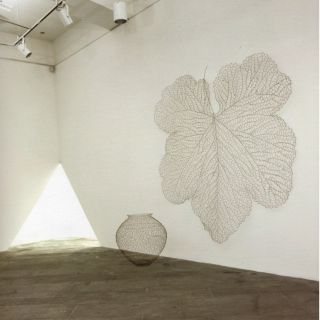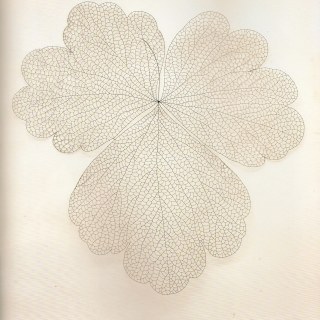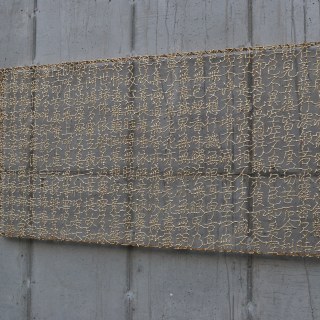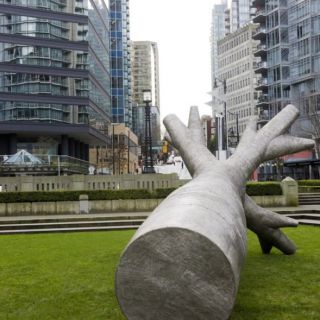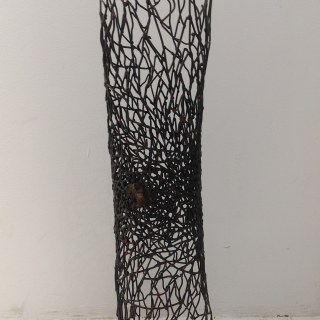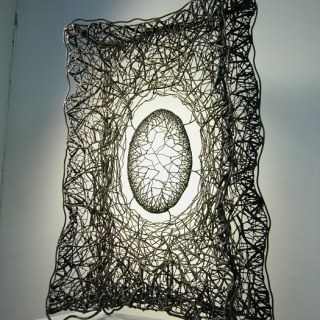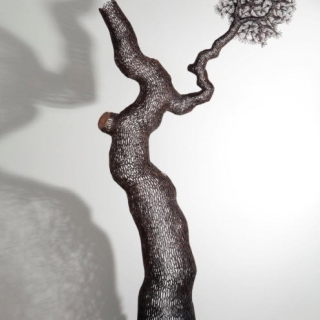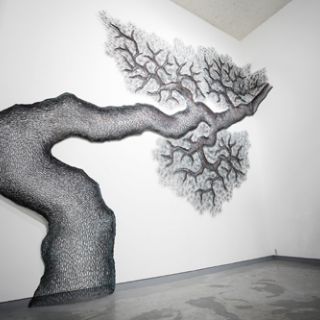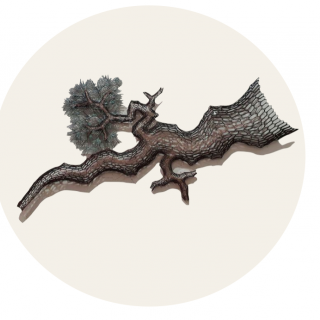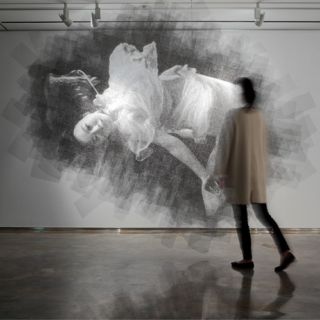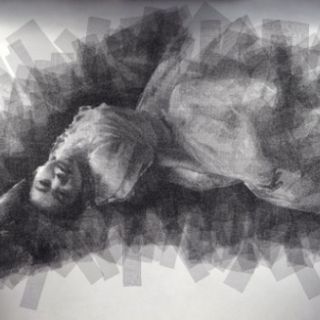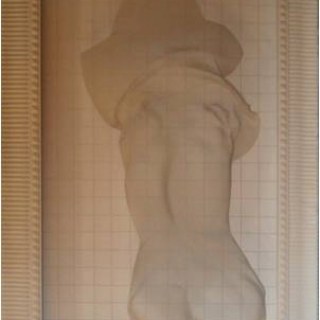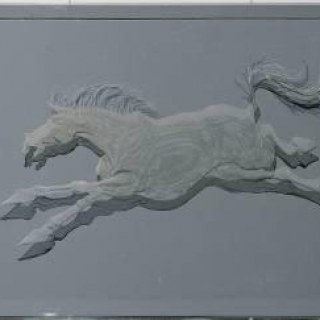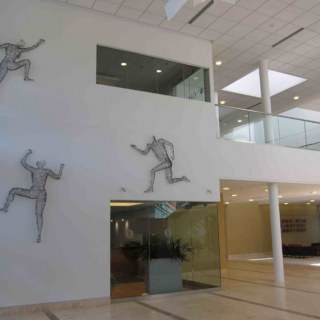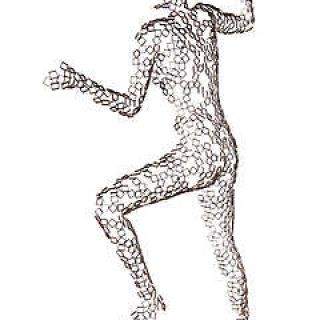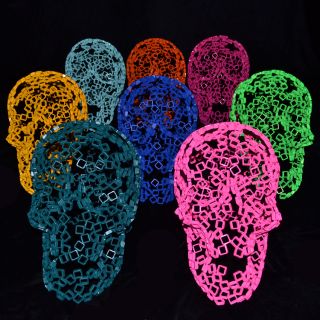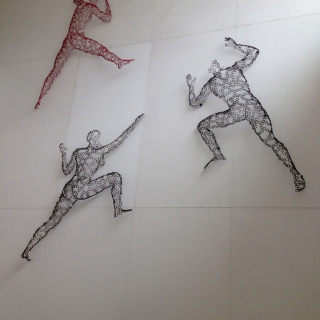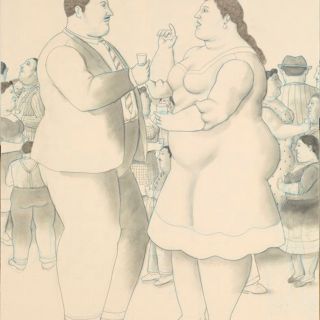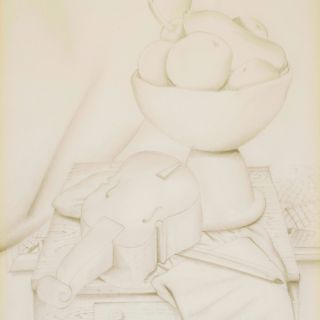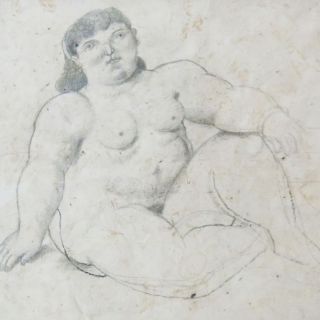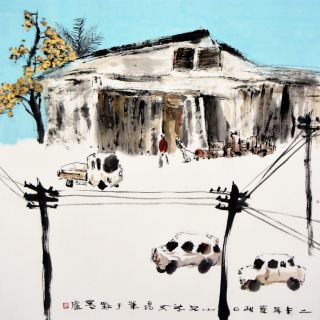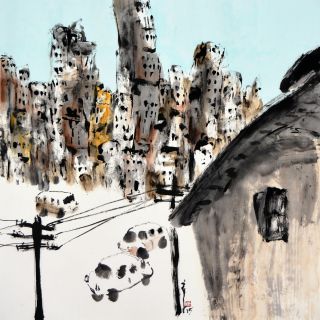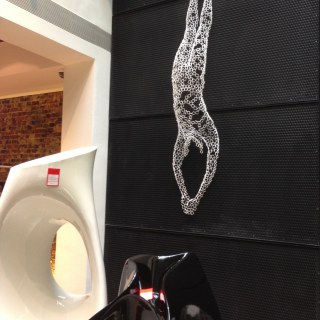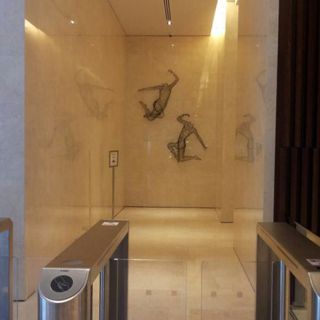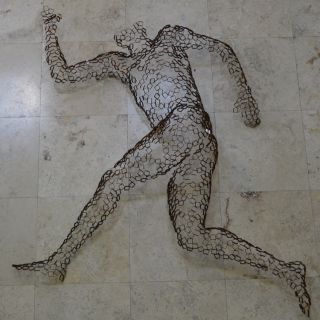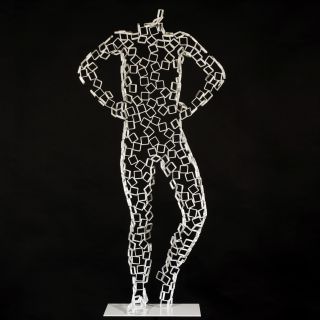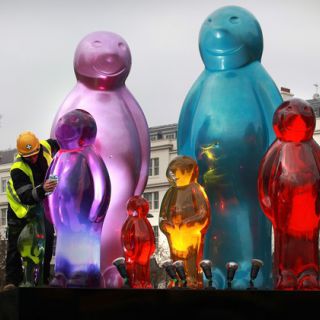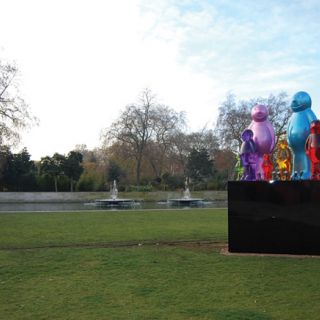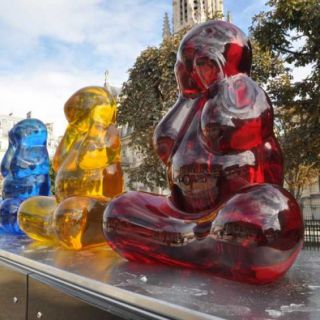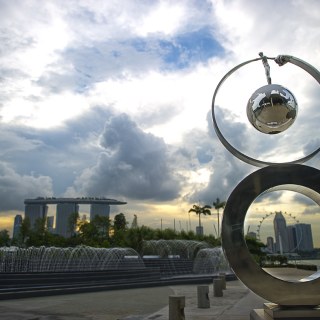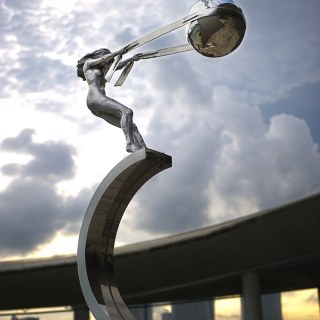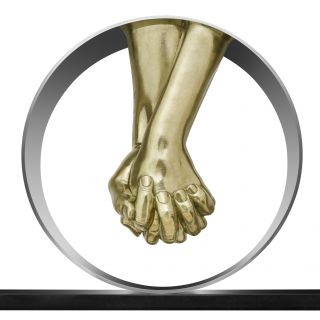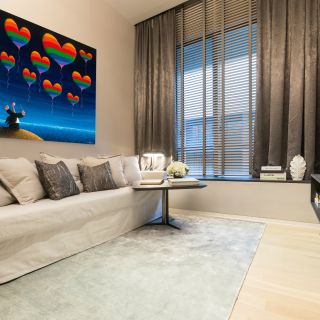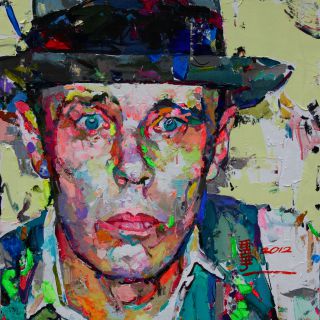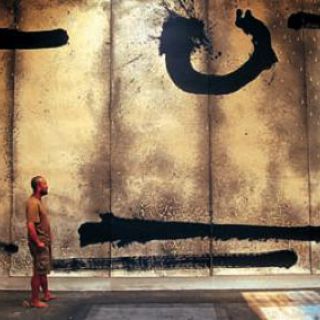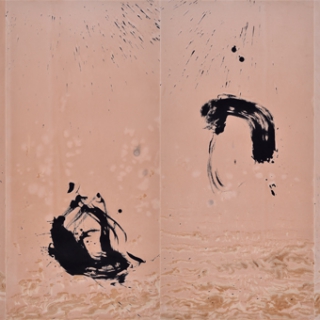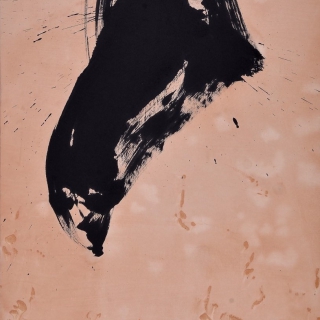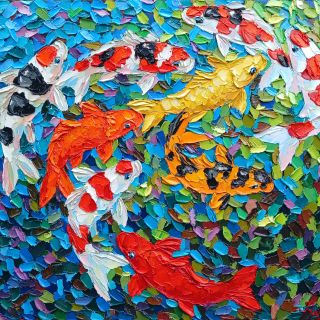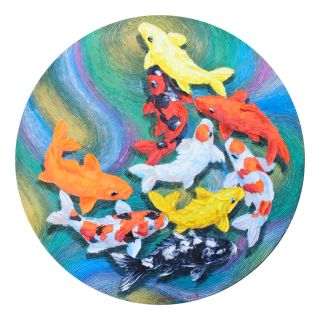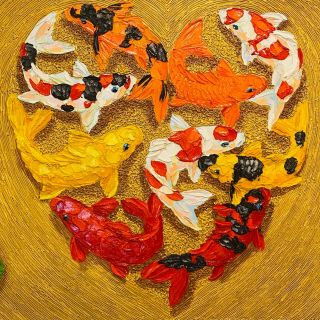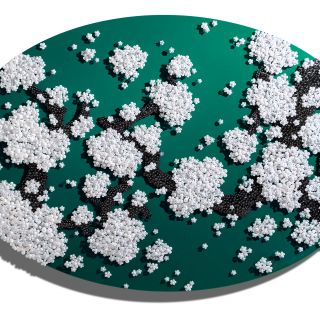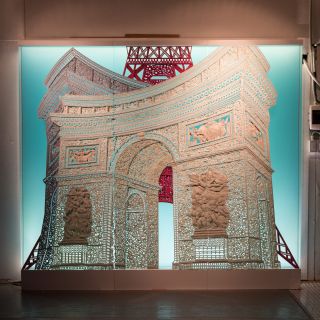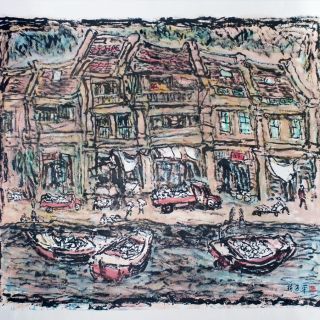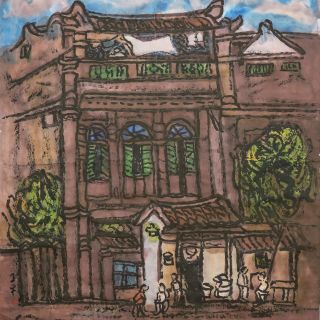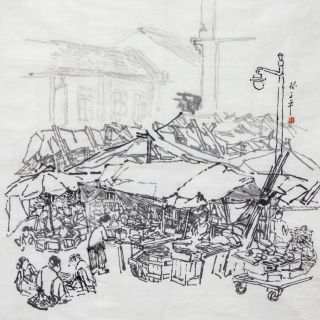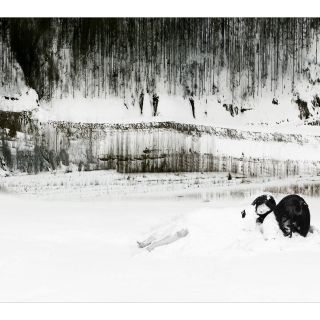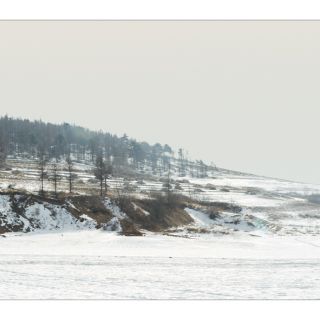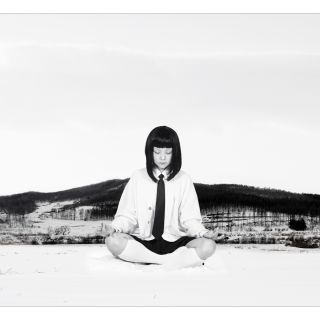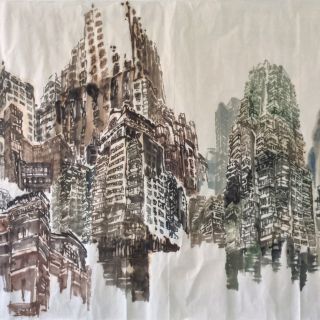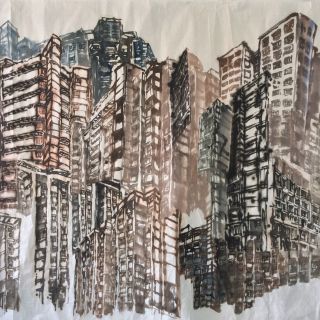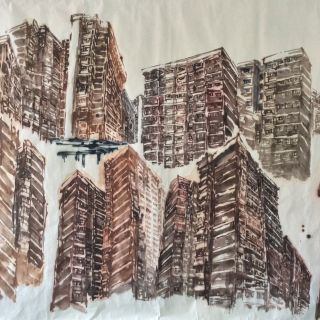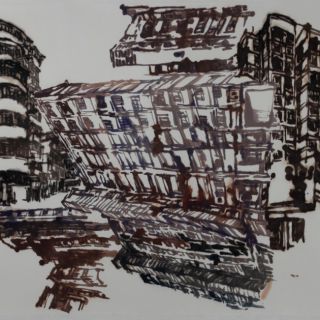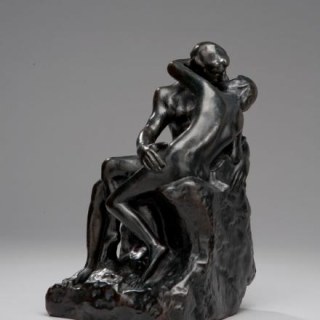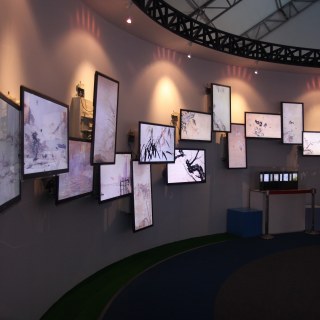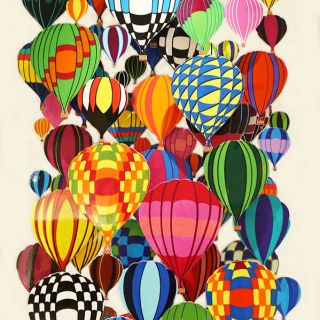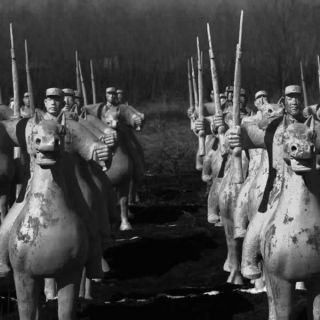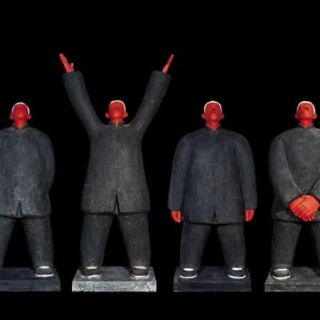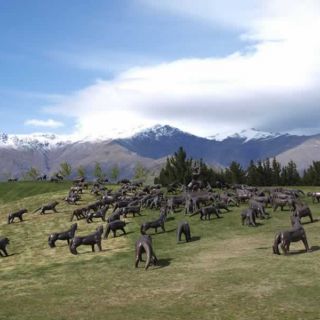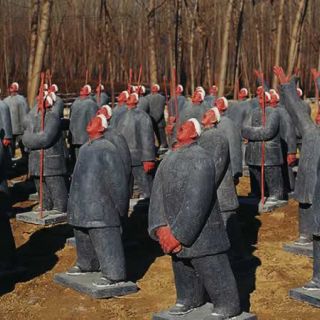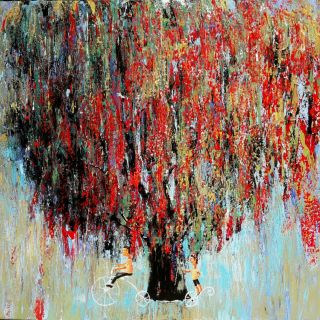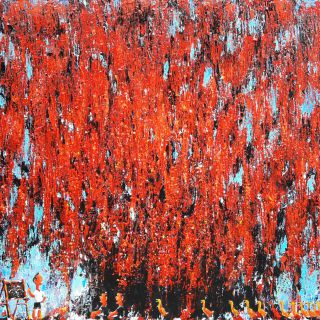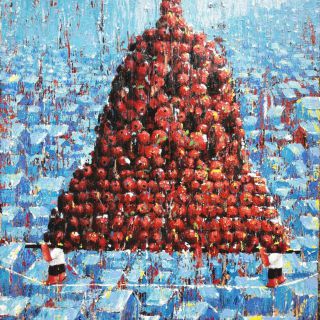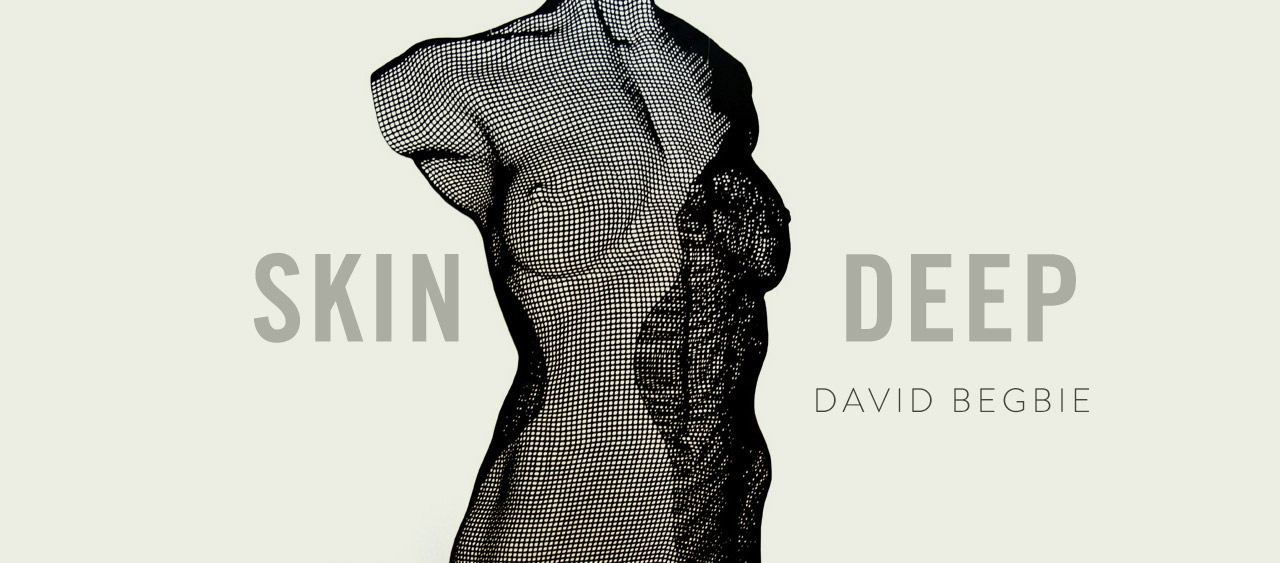
Born in Edinburgh in 1955, David Begbie has
shared his unique vision in numerous exhibitions across the world, including
Italy, France, Monoco, Canada, The Netherlands, United Kingdom, Austria,
Germany, USA, Australia, Japan and Spain. His robust and deceptive sculptures
are created by David coaxing the figures from steel mesh with his own hands,
creating a dual aesthetic with shadows and light. Globally acclaimed, the
artist’s works are found in a multitude of prestigious museum collections and
public art installations around the world and have also been commissioned for various
established corporations.
Viewing 8 works by David Begbie
Sort
Biography 
Biography
David Begbie discovered the particular properties of steel and bronze mesh as an art student in 1977. Since then his work has been exhibited globally and has been an enormous inspiration to people including architects, designers, photographers, actors, dancers and collectors as well as other artists. His work has been imitated and copied worldwide and the quality speaks for itself.
The preoccupation with the human form as his subject stems from an early age, the fascination for reproducing figurative bodies in mesh has developed extensively over many years. David Begbie achieves fine sculpting detail of musculature and an aesthetic completeness of human form which has even been compared to Michelangelo and Rodin, even though his subject is often that of the partial or truncated figure.
Background
Born in Edinburgh, Scotland in 1955 David Begbie’s earliest memories and experiences as an artist are at the age of 13. Already talented, Begbie completed seven years at art school where he emerged with a unique sculptural technique and the beginnings of a new visual language using steel mesh. Since his graduation in 1982 he has worked almost exclusively with the human form, primarily sculpting in steel mesh but also producing monoprints, etchings, ink and charcoal drawings mixed-media work and photographs. It is for his distinctive mesh sculpture that Begbie is most renowned.
Steel Mesh
Steel or bronze mesh is transparent – 90% thin air, yet it has as a much greater physical presence than any conventional solid form. Begbie’s skill, perception, understanding and imagination are succinctly contained within the confines of the simple shell that constitutes his sculpture.
The Lighting
The introduction of strategic lighting as an integral part of a particular composition has the most remarkable result where the combination of two and three dimensions, with the use of projected shadows, produces an optical fusion of image and object.
Steel Panel
The introduction of strategic lighting as an integral part of a particular composition has the most remarkable result where the combination of two and three dimensions, with the use of projected shadows, produces an optical fusion of image and object. It is from this phenomenon that Begbie developed his flat steel panel sculptures which are available in fine art limited editions. Begbie envisaged these works as existing and occupying a space between the three dimensional sculpture and the shadow itself, and in the process has created another new art form. The limited edition sculptures (flat panel work) are a mixture of sculpture and photography. To produce one of the sculptures in a flat steel panel, David must first have made a unique sculpture. It's photograph is then etched out of steel panel.
The portraits are even more of an amalgamation of the two disciplines, with David using the mesh to hold the features together. This new art-form developed in 2005, has enabled David to explore the potential of a single artwork - using colours and different formats to produce variations in mood and effect.
Sculpture Effect
The real thrill of Begbie’s work is the experience of seeing it "in the flesh,” the sculpted bodies are powerful, erotic, tactile, and intimate. For the viewer this material adds intrigue yet is somehow familiar; when you first experience Begbie’s bodies you are curious to know how the perfection of form is achieved.
Upon looking further, you become familiar with the properties of the medium - the wire mesh creates a liveliness and sense of movement further enhanced by the use of shadowplay with lighting. Look again closely and you see that there is not even skin, only the graphic delineation of it. In relation to the space it occupies, the catalytic effect a Begbie sculpture has, in any setting, given that it has no palpable substance or surface, is phenomenal. Begbie says of his sculpture “each work is an entity which has a far greater physical presence than any solid object could possibly have because it has the power to suggest that it doesn’t exist.” You have to touch a Begbie to make sure it does.
Museum Collections and Public Installations
2013 Hotel Linde, Mariaworth Austria “Antu”2013 'SOLA', Mews of Mayfair, Knightsbridge, London
2012 Buddha-Bar, Knightsbridge, London
2010 Hanover Grange, Montego Bay, Jamaica “Statu I and Statu II” and “Nuwdstill”
2008 The All England Lawn Tennis And Croquet Club, Centre Court Wimbledon “Grandslam”
2008 Coloplast Limited, Peterborough, England “Olo”
2007 Way of Therapy, London “Otuu”
2007 Radisson Edwardian Hotel, Providence Wharf, Genus Series “Venus” and “Veni”
2006 San Domenico House “Nuuda” “Nuudu” “Tunuud”
2006 62 Threadneedle Street –“Totu”
2005 Shrine of Walsingham, Norfolk “Crucifix”
2005 The Jam House, Edinburgh “Aangel”
2004 Hotel Linde, Mariaworth Austria “Nuda”
2004 Radisson SAS Hotel, Stansted England “Standover”
2002 The Milan Bar, Grants of Croydon, London “Anangel”
2001 Ten Covent Garden, Connaught Rooms, London “Heavenlybodies”
2001 The Lowry Hotel, Manchester, England “Suspense”
2000 Fleet Place House, Holborn Viaduct “Fishnet” 2000 Bede’s World Museum, Jarrow, Tyne & Wear “Worldsapart”
The preoccupation with the human form as his subject stems from an early age, the fascination for reproducing figurative bodies in mesh has developed extensively over many years. David Begbie achieves fine sculpting detail of musculature and an aesthetic completeness of human form which has even been compared to Michelangelo and Rodin, even though his subject is often that of the partial or truncated figure.
Background
Born in Edinburgh, Scotland in 1955 David Begbie’s earliest memories and experiences as an artist are at the age of 13. Already talented, Begbie completed seven years at art school where he emerged with a unique sculptural technique and the beginnings of a new visual language using steel mesh. Since his graduation in 1982 he has worked almost exclusively with the human form, primarily sculpting in steel mesh but also producing monoprints, etchings, ink and charcoal drawings mixed-media work and photographs. It is for his distinctive mesh sculpture that Begbie is most renowned.
Steel Mesh
Steel or bronze mesh is transparent – 90% thin air, yet it has as a much greater physical presence than any conventional solid form. Begbie’s skill, perception, understanding and imagination are succinctly contained within the confines of the simple shell that constitutes his sculpture.
The Lighting
The introduction of strategic lighting as an integral part of a particular composition has the most remarkable result where the combination of two and three dimensions, with the use of projected shadows, produces an optical fusion of image and object.
Steel Panel
The introduction of strategic lighting as an integral part of a particular composition has the most remarkable result where the combination of two and three dimensions, with the use of projected shadows, produces an optical fusion of image and object. It is from this phenomenon that Begbie developed his flat steel panel sculptures which are available in fine art limited editions. Begbie envisaged these works as existing and occupying a space between the three dimensional sculpture and the shadow itself, and in the process has created another new art form. The limited edition sculptures (flat panel work) are a mixture of sculpture and photography. To produce one of the sculptures in a flat steel panel, David must first have made a unique sculpture. It's photograph is then etched out of steel panel.
The portraits are even more of an amalgamation of the two disciplines, with David using the mesh to hold the features together. This new art-form developed in 2005, has enabled David to explore the potential of a single artwork - using colours and different formats to produce variations in mood and effect.
Sculpture Effect
The real thrill of Begbie’s work is the experience of seeing it "in the flesh,” the sculpted bodies are powerful, erotic, tactile, and intimate. For the viewer this material adds intrigue yet is somehow familiar; when you first experience Begbie’s bodies you are curious to know how the perfection of form is achieved.
Upon looking further, you become familiar with the properties of the medium - the wire mesh creates a liveliness and sense of movement further enhanced by the use of shadowplay with lighting. Look again closely and you see that there is not even skin, only the graphic delineation of it. In relation to the space it occupies, the catalytic effect a Begbie sculpture has, in any setting, given that it has no palpable substance or surface, is phenomenal. Begbie says of his sculpture “each work is an entity which has a far greater physical presence than any solid object could possibly have because it has the power to suggest that it doesn’t exist.” You have to touch a Begbie to make sure it does.
Museum Collections and Public Installations
2013 Hotel Linde, Mariaworth Austria “Antu”2013 'SOLA', Mews of Mayfair, Knightsbridge, London
2012 Buddha-Bar, Knightsbridge, London
2010 Hanover Grange, Montego Bay, Jamaica “Statu I and Statu II” and “Nuwdstill”
2008 The All England Lawn Tennis And Croquet Club, Centre Court Wimbledon “Grandslam”
2008 Coloplast Limited, Peterborough, England “Olo”
2007 Way of Therapy, London “Otuu”
2007 Radisson Edwardian Hotel, Providence Wharf, Genus Series “Venus” and “Veni”
2006 San Domenico House “Nuuda” “Nuudu” “Tunuud”
2006 62 Threadneedle Street –“Totu”
2005 Shrine of Walsingham, Norfolk “Crucifix”
2005 The Jam House, Edinburgh “Aangel”
2004 Hotel Linde, Mariaworth Austria “Nuda”
2004 Radisson SAS Hotel, Stansted England “Standover”
2002 The Milan Bar, Grants of Croydon, London “Anangel”
2001 Ten Covent Garden, Connaught Rooms, London “Heavenlybodies”
2001 The Lowry Hotel, Manchester, England “Suspense”
2000 Fleet Place House, Holborn Viaduct “Fishnet” 2000 Bede’s World Museum, Jarrow, Tyne & Wear “Worldsapart”
Exhibitions 
Exhibitions
Selected Exhibitions
2016
In the Heat of the Night, Continuum Gallery, Königswinter, Germany
Silhouette, Galerie Hegemann, Munich, Germany
David Begbie, Van Loon Galleries, Vught, The Netherlands
2015
SOLID AIR, Vecchiato Arte, Padova, Italy
Grand Summer Exhibition, Albemarle Gallery, London
2014
Opiom Gallery Settles In Miami, Opiom Gallery, Opio
’Solo Salon Show’ Townhouse - Spitalfields, London with Tanner & Lawson, London
2011
‘Archetypes’, Moorhouse, London
’Skindeep’, Ode to Art, Singapore
‘David Begbie’ Van Loon en Simons, Vught, Netherlands
‘GENUS’, Australian Galleries, Sydney
‘GENUS’, Australian Galleries, Melbourne
Soloshow ‘Soft Opening’, David Begbie Gallery, London W1
‘David Begbie’, Albemarle Gallery, London
2010
Gallery David Begbie, London
‘Thin Air’ Air Gallery, London
‘Aria Sottile’, Vecchiato Arte, Padua
‘Unud’, AM Gallery, Roquetas Del Mar, Almeria, Spain
‘Iconii’ Chapter House, Canterbury Cathedral
‘Archetypes’ Moorhouse, London
‘Skindeep’, Ode to Art, Singapore
2009
Gallery David Begbie London
‘Nudus’, Number Nine, Birmingham UK
Biennale, Galerie Van Loon en Simons, Vught,
Holland including ‘Rhythmic Ties’ violine concert
’Unud’ Somerville Gallery, Plymouth
Gallery David Begbie at Queens Elm Gallery, Chelsea, London including ‘Rythmic Ties’ Concert
2008
‘Genii’ Albemarle Gallery, London
Gallery David Begbie, London‘Grandslam
2008
maquette, (A.L.T.E.C. Wimbledon) exhibition
Albemarle Gallery, London
2007
Gallerie Il Ponte Contemporanea, Rome
Gallery David Begbie, London
Galerie Van Loon en Simmons, Netherlands
Form 2007 Olympia; London
‘Antebodies’ Buschlen Mowatt Galleries, Vancouver, Canada
2006
Gallery David Begbie London
Number Nine, Birmingham
2005
‘Nuduu’, Gallery David Begbie
The Catto Gallery, London
Etienne & Van Loon, Netherlands
Critique 
Critique
“Sculpture, we usually say without examining our proposition too closely, is of course a tactile art. We are most likely regretting the present-day hands-off policy of the great public art collections, however responsible in terms of conversation it may be, because after all you can obtain a much more intimate knowledge of a sculptor’s intentions, interests and achievements if you can actually run your hand over that curve and into the declivity, savour through your sense of touch the texture of stone or wood or metal. Which is true as far as it goes. But with David Begbie it does not go very far.
There is no doubt that Begbie is a sculptor. What else can you call someone who produces three-dimensional work in a material as palpable as fine steel mesh? And for that matter the comparisons that spring to mind are always with other sculptors. He may make us think of Medardo Rosso, who sought to capture similarly evanescent effects of fluidity and movement in the similarly evanescent medium of wax - though Begbie’s works, for all their apparent insubstantiality, are in fact amazingly sturdy. Or of Rodin for his passionate interest in the musculature of the human body, his fascination with the way the light falls on and moulds the shapes of human flesh.
And yet Begbie’s work must be the least tactile of all sculpture. If you touch a Begbie, what do you find out? Simply, that it is made of wire mesh. More complicatedly, that most of its visual effect is illusion. He is indeed, like Rodin, fascinated by the way that light falls on the human body, but he never reproduces the effect; he re-creates it in a highly illusionistic way. He is always playing with the intricate relationship between the eye and the mind, which enables us, forces us even, to see things which are not there, to place things in an imaginary space which corresponds to the real space before our eyes very little, if at all. Because of the very delicate and subtle fashion in which the mesh is moulded (mostly with his bare, strong fingers), extraordinary illusions are created, for as we look at the sculpture from different angles, the mesh takes on different visual densities, depending on the angle at which we see it, or whether we see it, as we do in some of the fully three-dimensional figures, in one thickness or two or three.”
John Russell Taylor, Critic and Author
“As he is a splendid sculptural draughtsman, the shape is exquisitely outlined. It has the rightness and the adjustment to observation, which in their absence we always miss in visual art. The steel mesh that makes these bodies also constitutes their imaginative clothing. It creates and iridescent fabric, with a fluttering sheen that is wantonly voluptuous, harsh yet silky, both at once. David Begbie weaves for imperial nakedness an optical garment, which is more illusory and stylish than ever.”
Sir Lawrence Gowing, Artist and Writer
“If one envisages the human form in sculpture one perhaps first thinks of it being carved in marble, since we all still wear what Henry Moore once referred to as ‘Greek spectacles’. Alternatively one might reflect on Donatello’s DAVID, which is arguably the most beautiful sculpture ever made. Or, perhaps nearer to our own time one thinks of Rodin’s powerfully modelled figures - and here we are getting closer to what David Begbie is seeking to create: an incomplete portion of the human body, a part which speaks eloquently for the whole. The foregoing examples are of the human body carved or modelled, solid either absorbing or reflecting light. Begbie has explored a further range of possibilities - his figures are transparent, made of wire mesh, modelled painted and galvanised: the light both ripples on the surface and passes right through them. The effect is of a presence that is not quite of this world. It is real, but also surreal.”
Mary Rose Beaumont, Art Historian and Critic
--
“His work is quite unlike anything else being done at the present moment. His figures and figure-fragments are moulded from fine wire mesh. These materials turn out to be extraordinarily sensitive: Begbie is able to shape it with his hands to produce the illusion of rippling musculature. He makes it seem as sensitive and pliable as wax. But the mesh provides a whole range of other effects as well - the sculptures become translucent - they are simultaneously there and not there. In this new series of works, Begbie has become much bolder - the figures are deliberately fragmented, metal armatures are used to ‘draw’ with, so that the spatial interaction becomes more complex. Every time the viewer shifts position, a new set of relationships appear. The fascinating thing is that these relationships remain coherent.”
Edward Lucie-Smith, Art Historian, Critic and Author
--
“David Begbie is a sculptor, draughtsman and printmaker whose materials and media are unusual but whose preoccupation – the human condition – is ancient. The first known paintings, the cave paintings of southern France, are of living creatures, animals in the main; even older however, are the first known sculptures: a very plump female in limestone, and a man in ivory both from Central Europe. The survivors - (and characteristically sculpture has a potential for survival denied to painting) – are associated with the art of the hunters, rather than with the more settled art of the farmers appearing substantially later. The famous dictum of Pope’s turns out to have been shared throughout the millennia, even if man and woman were dressed up or rather down, in the sense of being naked and observed – as a deity.
In the face of all creeds and isms, the most persistent motif – man is the measure of all things – characterises the formulation of imagery for all of human history. (Abstraction is bold, because it emphasises human absence the more powerfully in some instances to recall the human presence.) Therefore, in one sense, what is there still to say or show?
David Begbie’s human and humane art does demonstrate in contemporary terms and the human figure is inexhaustible as an inspiration in itself, and as itself, and as a way of saying all kinds of things about art – and life – now. First of all there is the refinement of the material. In the case of the three-dimensional figures, Begbie confounds sculptural preconceptions – particularly when related to figurative work. We are accustomed to seeing the figure carved in stone or cast in bronze, however we are also used to an enormous variety of material in the revolutionary formulations for sculpture so characteristic of this century. In a curious way, the figure itself is the last bastion. David Begbie does not, it seems to me, use the novelty of steel mesh and now copper, simply for its own sake. Rather, it is an extension and amplification of an earlier avant-garde – Julio Gonzalez, say, and his drawing in space with his welded metal sculpture. Their technical insights and expansions of possibilities were and are quarried by artists who have tended to abandon overt representation for a more oblique view of the world around us, relying more on an inner vision, a sense of constructing from within.
I do not believe that David Begbie’s seemingly accurate (although they are not; artistic licence is subtly, imaginatively and interestingly at work) visual mediations on the human figure and face could in fact have been created without the liberty afforded to artists by photography and its apparent faithfulness to the observed world (although we know that fidelity to be false as well). Nor could the evolution and development of his highly individual idiom have taken place without the freedom afforded figuration by abstraction.
Effective art must be of its time, as well as containing within it some understanding of tradition and the past. David Begbie’s art is exhilarating and fascinating precisely because he deals directly with a subject that could not be more ancient and traditional, but does so in ways that are only possible now. He uses traditional and invented techniques. He uses the human form, but his art mediates it into a series of works, highly individual, that communicate a recognisable, emotionally authentic and affecting interpretation that is his own.”
Marina Vaizey, Art Critic
There is no doubt that Begbie is a sculptor. What else can you call someone who produces three-dimensional work in a material as palpable as fine steel mesh? And for that matter the comparisons that spring to mind are always with other sculptors. He may make us think of Medardo Rosso, who sought to capture similarly evanescent effects of fluidity and movement in the similarly evanescent medium of wax - though Begbie’s works, for all their apparent insubstantiality, are in fact amazingly sturdy. Or of Rodin for his passionate interest in the musculature of the human body, his fascination with the way the light falls on and moulds the shapes of human flesh.
And yet Begbie’s work must be the least tactile of all sculpture. If you touch a Begbie, what do you find out? Simply, that it is made of wire mesh. More complicatedly, that most of its visual effect is illusion. He is indeed, like Rodin, fascinated by the way that light falls on the human body, but he never reproduces the effect; he re-creates it in a highly illusionistic way. He is always playing with the intricate relationship between the eye and the mind, which enables us, forces us even, to see things which are not there, to place things in an imaginary space which corresponds to the real space before our eyes very little, if at all. Because of the very delicate and subtle fashion in which the mesh is moulded (mostly with his bare, strong fingers), extraordinary illusions are created, for as we look at the sculpture from different angles, the mesh takes on different visual densities, depending on the angle at which we see it, or whether we see it, as we do in some of the fully three-dimensional figures, in one thickness or two or three.”
John Russell Taylor, Critic and Author
“As he is a splendid sculptural draughtsman, the shape is exquisitely outlined. It has the rightness and the adjustment to observation, which in their absence we always miss in visual art. The steel mesh that makes these bodies also constitutes their imaginative clothing. It creates and iridescent fabric, with a fluttering sheen that is wantonly voluptuous, harsh yet silky, both at once. David Begbie weaves for imperial nakedness an optical garment, which is more illusory and stylish than ever.”
Sir Lawrence Gowing, Artist and Writer
“If one envisages the human form in sculpture one perhaps first thinks of it being carved in marble, since we all still wear what Henry Moore once referred to as ‘Greek spectacles’. Alternatively one might reflect on Donatello’s DAVID, which is arguably the most beautiful sculpture ever made. Or, perhaps nearer to our own time one thinks of Rodin’s powerfully modelled figures - and here we are getting closer to what David Begbie is seeking to create: an incomplete portion of the human body, a part which speaks eloquently for the whole. The foregoing examples are of the human body carved or modelled, solid either absorbing or reflecting light. Begbie has explored a further range of possibilities - his figures are transparent, made of wire mesh, modelled painted and galvanised: the light both ripples on the surface and passes right through them. The effect is of a presence that is not quite of this world. It is real, but also surreal.”
Mary Rose Beaumont, Art Historian and Critic
--
“His work is quite unlike anything else being done at the present moment. His figures and figure-fragments are moulded from fine wire mesh. These materials turn out to be extraordinarily sensitive: Begbie is able to shape it with his hands to produce the illusion of rippling musculature. He makes it seem as sensitive and pliable as wax. But the mesh provides a whole range of other effects as well - the sculptures become translucent - they are simultaneously there and not there. In this new series of works, Begbie has become much bolder - the figures are deliberately fragmented, metal armatures are used to ‘draw’ with, so that the spatial interaction becomes more complex. Every time the viewer shifts position, a new set of relationships appear. The fascinating thing is that these relationships remain coherent.”
Edward Lucie-Smith, Art Historian, Critic and Author
--
“David Begbie is a sculptor, draughtsman and printmaker whose materials and media are unusual but whose preoccupation – the human condition – is ancient. The first known paintings, the cave paintings of southern France, are of living creatures, animals in the main; even older however, are the first known sculptures: a very plump female in limestone, and a man in ivory both from Central Europe. The survivors - (and characteristically sculpture has a potential for survival denied to painting) – are associated with the art of the hunters, rather than with the more settled art of the farmers appearing substantially later. The famous dictum of Pope’s turns out to have been shared throughout the millennia, even if man and woman were dressed up or rather down, in the sense of being naked and observed – as a deity.
In the face of all creeds and isms, the most persistent motif – man is the measure of all things – characterises the formulation of imagery for all of human history. (Abstraction is bold, because it emphasises human absence the more powerfully in some instances to recall the human presence.) Therefore, in one sense, what is there still to say or show?
David Begbie’s human and humane art does demonstrate in contemporary terms and the human figure is inexhaustible as an inspiration in itself, and as itself, and as a way of saying all kinds of things about art – and life – now. First of all there is the refinement of the material. In the case of the three-dimensional figures, Begbie confounds sculptural preconceptions – particularly when related to figurative work. We are accustomed to seeing the figure carved in stone or cast in bronze, however we are also used to an enormous variety of material in the revolutionary formulations for sculpture so characteristic of this century. In a curious way, the figure itself is the last bastion. David Begbie does not, it seems to me, use the novelty of steel mesh and now copper, simply for its own sake. Rather, it is an extension and amplification of an earlier avant-garde – Julio Gonzalez, say, and his drawing in space with his welded metal sculpture. Their technical insights and expansions of possibilities were and are quarried by artists who have tended to abandon overt representation for a more oblique view of the world around us, relying more on an inner vision, a sense of constructing from within.
I do not believe that David Begbie’s seemingly accurate (although they are not; artistic licence is subtly, imaginatively and interestingly at work) visual mediations on the human figure and face could in fact have been created without the liberty afforded to artists by photography and its apparent faithfulness to the observed world (although we know that fidelity to be false as well). Nor could the evolution and development of his highly individual idiom have taken place without the freedom afforded figuration by abstraction.
Effective art must be of its time, as well as containing within it some understanding of tradition and the past. David Begbie’s art is exhilarating and fascinating precisely because he deals directly with a subject that could not be more ancient and traditional, but does so in ways that are only possible now. He uses traditional and invented techniques. He uses the human form, but his art mediates it into a series of works, highly individual, that communicate a recognisable, emotionally authentic and affecting interpretation that is his own.”
Marina Vaizey, Art Critic

Stay connected.
Sign up to our newsletter for updates on new arrivals and exhibitions


